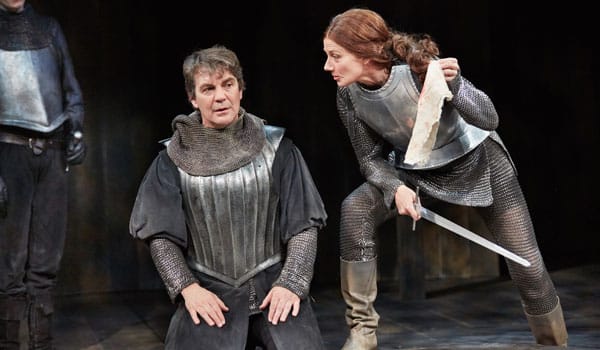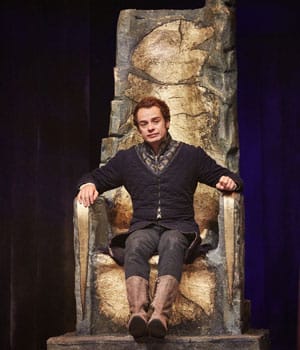
The Wars Of The Roses: Edward IV
Rose Theatre, Kingston
03/10/15
4 Stars
‘Gives not the hawthorn-bush a sweeter shade
To shepherds looking on their silly sheep,
Than doth a rich embroider’d canopy
To kings that fear their subjects’ treachery?’
The second part of the Wars of the Roses trilogy has many of the virtues of Henry VI and I shall not rehearse them again here in detail. Suffice to say that Barton and Hall attempt to clarify the bewildering blizzard of switched allegiances, broken promises and inconclusive battles that form the later section of Shakespeare’s Henry plays, and largely succeed in doing so. The cast-list is simplified, scenes are tweaked or moved around, battles omitted, and the end result is much more structured and fluent and compelling than the original. All sorts of symmetries and connections that are buried in detail in the original are here memorably brought to the surface. There is no loss however of cherished sections of poetry or of characters central to the drama as the conflict intensifies between adherents of the white or red rose.
The end result is not quite so well shaped as Henry VI – though through no fault of the adaptation. Quite simply Edward IV is a transitional play in which some of the characters who are introduced in the first – eg the Duke of York, Queen Margaret, Henry VI himself, and the Earl of Warwick -are fully developed and depart; and other roles – Richard of Gloucester (the future Richard III), his brother Clarence, and Queen Elizabeth – make their entrance. Edward IV himself is only a major player in the second half of the play and cannot therefore act as a binding force across the whole, quite apart from the fact that he is a weak and vacillating figure. The play therefore lacks the structural rigour that Barton finds in Henry VI, and which Shakespeare finds for himself so spectacularly in Richard III.
What are most worthwhile in this play therefore are the political and personal rivalries that develop between York (Alexander Hanson), Warwick (Timothy Walker) and Queen Margaret (Joely Richardson) with the contribution of Henry VI himself (Alex Waldmann) akin to that of a chorus of lamentation at the margins. The strength of the acting in these roles ensures that this is riveting viewing, though memories of Donald Sinden, Peggy Ashcroft, Brewster Mason and David Warner are not eclipsed (and can still be seen in grainy snippets on YouTube).
Barton and Hall were clear that their main justification for this adaptation was in showing how relevant as a commentary on contemporary politics Shakespeare’s drama still is. This play is, of the three, the one that on the surface conforms most closely to Game of Thrones, and therefore it is important for me to illustrate by reference to a number of scenes how it goes well beyond mere historical machination as entertainment.

Some of the best moments are there because Barton has enhanced the original. When York finally gets to sit briefly on the magnificent throne, an edifice worthy of Lord of the Rings, he asks ‘What royal title is proof?’ and we have in what follows a wonderful set of meditations, exactly half way through the triptych, on the transitoriness of power, the vanity of aspiration in all the characters, and a touching moment of fully dramatised insight too – that the man who has laboured so hard to get to the top in fact has no idea what he will do with the power that now seems at last to lie within reach.
But the finest scenes are still mainly Shakespeare’s own. The death of York at the hands of Margaret has to be played for full-on horror, and here it is. Queen Margaret gains vengeance for the earlier murder of her lover, by humiliating her great opponent and then wiping his face with a cloth soaked in the blood of one of his sons. Her hysterical laughter, given full measure by Richardson, stands as a stark symbol for how civil war devours and mutates those who practice it.
As a deliberate contrast in mood to this gore-fest, Henry VI’s rumination on his misfortunes as he looks down on a battlefield where a father has killed a son and a son a father stands out as a scene worthy of Beckett. Yet it is all Shakespeare’s original work, not a reshaping. Waldmann’s performance captures a regretful simplicity and grace while still doing full justice to the rhetorical forms of the highly artificial writing. Literary form, political lesson and emotional power, all lock together perfectly.
Shakespeare and Barton are both conscious of the need to demonstrate the involvement of the common people and the impact of civil war on those outside the political elite. So the episode devoted to Cade’s Rebellion is crucial as a dramatic contrast to the quarrels of the barons and as a general change of tone. Rufus Hound, as Cade, certainly gets the biggest laugh of the day with his injunction to ‘Kill all the Lawyers!’ But he also gives a very sympathetic, fully developed portrayal of an uneducated man with strong native wit and a gift of the gab outwitted by political insiders. Again there are neat contemporary parallels here, worthy of House of Cards in the way that the rebellion is put down by both invoking the memory of Henry V and offering bribes to get the populace to divert their energies into fighting the French.
As we move into the later stages of the play it is the rise of Richard of Gloucester that commands our attention rather than that of the ostensible victor and soft sensualist, Edward IV (Kåre Conradi). Robert Sheehan shows real skill in showing how to ‘add colours to the chameleon.’ His front of stage soliloquies grow in wit, charming malevolence and flair to the extent that he stopped the show with applause. This prepares us for one of the finest scenes in the trilogy – the murder of Henry VI in the Tower – the confrontation between the standard-bearers for undiluted goodness and evil. Both Sheehan and Waldmann are outstanding here but it is the gentle kiss Henry gives Richard just before the fatal blow, a gesture carried over from the original production, that makes the most eloquent dramatic point of all.
Trevor Nunn and his creative team guide the overall success of the production, but often in unobtrusive ways. With so many changes of scene the actors need to press things forward all the time: they are already on stage when the audience resume their seats; scenery is kept to a minimum; and in a particularly nice touch swords are extracted from or slotted into holes in the side of the forestage as needed. Fight director Michael Ranson ensures that the battles are convincing but not monotonous – the routines are varied, not repeated, and blood is only used where specifically mentioned in the text. Gruesomeness is more subtly evoked using the audience’s imagination instead.
Props are few and costume is armoured and muted unless ceremonial demands more. Over and above the scenes of battle there is plenty of movement and the visual dimension is never neglected with good use of the balconies and different levels in the set. We end with a staged dance to celebrate the ascendancy of the three suns of York, but with Richard of Gloucester set and speaking to one side. The false pageantry and pretension of Edward’s court is already clear, as is the source of its imminent dissolution.
Read Tim’s review of Henry VI
Read Tim’s review of Richard III
